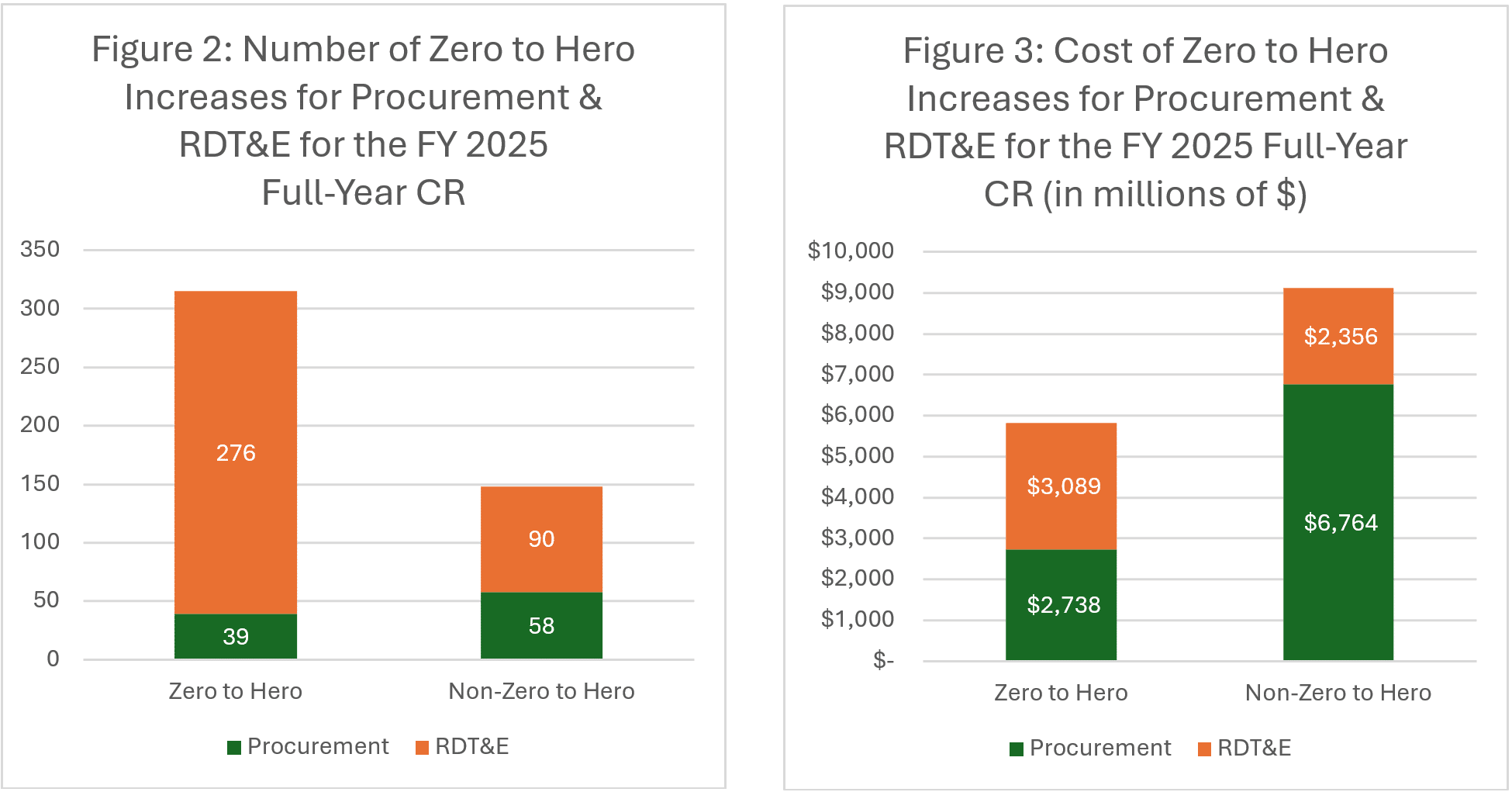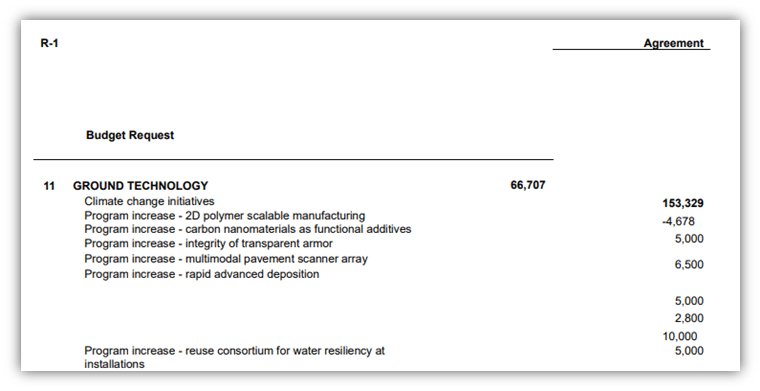Introduction
Every year, lawmakers add billions of dollars to the Pentagon budget, spread out across hundreds of program increases. The latest edition of a Taxpayers for Common Sense (TCS) database tells the story of these congressional Pentagon budget increases in the Fiscal Year 2025 budget. Program increases to the Pentagon budget often operate as de facto earmarks, allowing lawmakers to allocate funds to programs and projects that may benefit their constituents and campaign contributors.
Like the archived data on the previous fiscal year, this edition of the database shows congressional increases for Pentagon Procurement and Research, Development, Test & Evaluation (RDT&E) accounts. However, Fiscal Year 2025 saw unprecedented changes in the way Congress budgeted for the Pentagon, which the database reflects. While Congress routinely passes continuing resolutions (CRs) to fund the government at the previous fiscal year’s levels until a budget agreement can be reached, for Fiscal Year 2025, Congress passed H.R. 1968, the Full-Year Continuing Appropriations and Extensions Act of 2025, marking the first time that the Pentagon has ever operated under a full-year continuing resolution.
Traditionally, CRs cap spending at the previous fiscal year’s levels, with some relatively small exceptions known as anomalies for critical programs or to adjust for spending no longer needed. But this full-year CR included anomalies for virtually every Pentagon account and ultimately added $6 billion to national security spending above FY 2024 levels while cutting $13 billion from non-defense accounts.
CRs are also not traditionally accompanied by joint explanatory statements and funding tables that accompany regular appropriations bills. Furthermore, when these funding tables are included with regular appropriations bills, Congress has a chance to review them before voting on the final bill. However, this year, the week after Congress passed the full-year CR, Rep. Ken Calvert (R-CA) and Sen. Mitch McConnell (R-KY), the chairs of the House and Senate Defense Appropriations Subcommittees, sent a letter and funding tables to Secretary of Defense Pete Hegseth, claiming that the funding tables “indicate congressional intent for programs, projects, and activities (and the dollar amounts and adjustments to budget activities corresponding to such programs, projects, and activities) provided for in this Act [H.R. 1968].”
Given that these funding tables were only publicized after Congress had already voted on the full-year CR, and given reports that Democratic appropriators were not consulted prior to the submission of these tables, whether or not they truly represent congressional intent is an important question. However, these funding tables are the only complete instructions from Congress as to how the Pentagon should allocate funds at the program, project, and activity levels because the full-year CR only specifies topline funding at the account level, with a few exceptions. As such, the latest edition of the TCS database on congressional Pentagon budget increases includes a column titled “Full-Year CR Amount,” which lists the amounts provided for in the funding tables for each program increase for Procurement and RDT&E.
In total, the funding tables instruct the Pentagon to add $14,947,210,000 spread out over 463 program increases to the Pentagon’s Procurement and RDT&E accounts.
While this marks a reduction in congressional Pentagon budget increases compared to FY 2024, when lawmakers added over $21 billion to the Pentagon’s Procurement and RDT&E accounts, the number and cost of these increases is still remarkable given that the full-year CR forces most other government agencies to operate at or below FY 2024 funding levels. Given that national security spending received $6 billion over FY 2024 levels in the full-year CR, the nearly $15 billion cost of these increases further indicates that Congress cut billions of dollars in other parts of the budget in order to cover the cost of these increases.
Furthermore, the reduced size and scope of these increases compared to last year may not hold if Congress passes an additional Pentagon spending increase through reconciliation, a budget process originally designed to adjust direct spending and revenue to align with adopted budgets that has become a means of circumventing the Senate filibuster to pass major packages along party lines. Republican leadership in Congress is pursuing an increase in Pentagon spending through reconciliation in the range of $100 billion to $150 billion, to be applied over the next two to four years. If Congress passes a reconciliation bill with increases for Pentagon Procurement and RDT&E for FY 2025, TCS will update its database to reflect those increases.
Given these unusual circumstances, the high number and cost of program increases included in the full-year CR funding tables underscores that the congressional practice of adding billions of dollars in program increases to the Pentagon budget each year is both alive and well, and less susceptible to fiscal constraints than most other congressional appropriations.
Program Increases Are Backdoor Earmarks
While not technically earmarks under Congressional definitions, program increases serve a similar purpose. Formal earmarks fund specific projects with predetermined recipients, and are subject to transparency requirements in both the House and Senate. To secure an earmark, lawmakers are required to publicly attach their names to it, disclose the recipients, state the purpose of the earmark, and certify that neither they nor their immediate families have a financial interest in the earmark. House and Senate guidance also indicate that for-profit entities are ineligible for earmarks.
The FY 2025 full-year CR does not include earmarks, at least in the most technical sense. However, in practice, many of the 463 program increases included in the funding tables submitted by Defense Appropriation Chairs Calvert and McConnell will serve as de facto earmarks, only less transparent than their formal counterparts. Unlike the reporting requirements imposed on lawmakers for formal earmarks, lawmakers are not required to disclose their involvement in requesting program increases, explain the purpose of their program increases, or certify that they have no financial interest in the program increase. These increases also can and do lead to contracts that benefit for-profit entities.
According to the Calvert-McConnell letter, “For fiscal year 2025, the Department of Defense is directed to adhere to the definition of Program, Project and Activity, and to follow the guidance for Congressional Special Interest Items, Reprogrammings, Reprogramming Reporting Requirements, and Funding Increases as specified in the Explanatory Statement accompanying the Department of Defense Appropriations Act, 2024.”
The guidance regarding funding increases referenced in the letter can be found in the explanatory statement within the congressional record of the FY 2024 Defense Appropriations Act under a heading titled “Funding Increases,” which states:
The funding increases outlined in the tables for each appropriation account shall be provided only for the specific purposes indicated in the tables. It is directed that funding increases shall be competitively awarded, or provided to programs that have received competitive awards in the past.
While this language is meant to ensure that lawmakers cannot target funding increases for specific recipients, in practice, many of these program increases are so specific that only one Pentagon contractor is well-positioned to secure a contract award for the increase. This allows lawmakers to effectively target funds for specific recipients.
Furthermore, most program increases originate in the House and Senate Appropriations Committees, leaving no avenue for public scrutiny or debate regarding their merit or fiscal implications. Of the 463 program increases in the funding tables, only 25 were offered as House floor amendments (the Senate did not debate their bill on the floor). As amendment sponsors, specific lawmakers were tied to those 25 increases. However, these amendments were all passed en bloc, meaning they were voted on as a group with a single collective vote. That would have significantly limited debate on each individual increase had the House debated these en-bloc amendments on the House floor at all, which it did not.
The funding tables included another ten increases totaling $1.5 billion that responded to unfunded priorities lists (UPLs), extra-budgetary wish lists that Congress requires all of the military services and combatant commands to submit that seek funding for items not included in the budget request. Unfunded priority lists are a bad budgeting practice—they circumvent civilian control of the military by creating a separate budget request that is not subject to review and approval by the Secretary of Defense; they do not require the same level of justifications and cost analyses as funding in the base budget request; and they create a perverse incentive for the Pentagon to leave items out of the budget that would likely be included in UPLs and funded by Congress.
The lack of transparency, public debate, and genuinely competitive selection processes for many of these increases contribute to wasteful Pentagon spending. It empowers lawmakers to, for all intents and purposes, earmark funds for projects that will likely create jobs in their state or district, increase profits for companies that may have contributed to their campaigns, or both, all with limited public scrutiny.
Procurement and RDT&E
TCS’s database of congressional Pentagon budget increases focuses on Procurement and RDT&E, because that is where the military industry asserts the most influence over the Pentagon budget process. Of the 463 program increases for Procurement and RDT&E included in the funding tables for the full-year CR, 97 were for Procurement, and 366 were for RDT&E. However, the bulk of the cost of these increases fell under Procurement with a price tag of about $9.5 billion compared to the $5.45 billion cost of RDT&E increases. Both the number and cost of these program increases are lower than the increases for Procurement and RDT&E in the final FY 2024 Pentagon appropriations bill.
Again, the overall reduction in the number and cost of program increases for Procurement and RDT&E in the FY 2025 full-year CR compared to the prior fiscal year is not an indication of congressional restraint. On the contrary, the fact that the funding tables retained nearly $15 billion in increases even under the extreme fiscal circumstances of a full-year CR underscores Congress’ lack of fiscal restraint when it comes to padding the Pentagon budget. If congressional Republicans are successful in passing another Pentagon budget increase through reconciliation, the final cost of FY 2025 increases will very likely surpass the cost of FY 2024 increases by a large margin.
Zero to Hero
Many of the program increases typically included in the funding tables for Pentagon appropriations are for projects that the Pentagon did not fund at all in its budget request for the year in question. TCS refers to these as “Zero to Hero” increases.
Of the 463 program increases for Procurement and RDT&E in the funding tables for the full-year CR, 315 (68 percent) were for projects that the Pentagon did not request any funding for in its FY 2025 budget request. Within Procurement, 39 of the total 97 program increases (40 percent) were for Zero to Hero increases. Within RDT&E, 276 of 366 total increases (75 percent) were for Zero to Hero increases. By cost, about $2.73 billion of the $9.5 billion for Procurement (28 percent) was for Zero to Hero increases, while about $3.09 billion of the $5.45 billion for RDT&E (57 percent) was for Zero to Hero increases.
Some Zero to Hero program increases in the funding tables for the full-year CR were for major programs that the Pentagon (under the previous administration) did not want to pursue. For instance, in its 2022 Nuclear Posture Review, the Biden administration proposed cancelling the Nuclear-Armed Sea-Launched Cruise Missile (SLCM-N), a wise position given concerns that fielding nuclear-armed missiles on conventional attack submarines could undermine the non-nuclear missions of those submarines, among other strategic concerns. While the missile received no funding in the FY 2025 budget request, the funding tables for the full-year CR included $150 million for the missile, qualifying it as a Zero to Hero increase. This reflects a disagreement between Congress and the administration on policy, and it is Congress’ prerogative to act on such disagreements when it crafts the budget.
However, the majority of Zero to Hero increases are for relatively small projects that may not have even been on the Pentagon’s radar when it submitted its budget request. For instance, $5 million program increases for “gallium oxide for higher power electronics” and “self-extinguishing and thermal isolating materials” were most likely the result of Pentagon contractors lobbying lawmakers to include funding for these projects in hopes of reaping the awards (which is not to say that the inclusion of funding for the SLCM-N was not also a result of military industry lobbying). The highly specific nature of these increases is Congress’ way of ensuring that the funds end up with the intended recipients, even though they are supposed to be competitively awarded, or awarded for projects that received competitive awards in the past.
While it is also Congress’ prerogative to add funding for small projects like these, unlike funding for SLCM-N, this type of funding goes virtually unnoticed by many in Congress let alone the public. Yet collectively, all of these small increases end up costing taxpayers billions of dollars each year.
Unfunded Priorities
In the funding tables accompanying the House and Senate versions of the FY 2025 Pentagon spending bill, lawmakers originally proposed adding over $5 billion spread across 34 program increases for Procurement and RDT&E in response to the Pentagon’s unfunded priority lists. In the funding tables for the full-year CR, Rep. Calvert and Sen. McConnell retained ten of those increases, at a cost of over $1.5 billion. Eight of those increases were for Procurement, while two were for RDT&E.
Most of the cost of these increases was associated with the procurement of additional aircraft beyond what the Pentagon requested for its FY 2025 budget. They include $524 million for four additional F-35Cs, $196 million for two additional F-35As, $261 million for two additional KC-130Js, and $125 million for one additional CH-53K.
The inclusion of funding for additional F-35’s is particularly troubling. Due to a long list of shortcomings, the F-35 has a full mission capable rate of about 30 percent, meaning these planes are only able to fly and perform all of their missions 30 percent of the time. The Pentagon’s FY 2025 budget request proposed cutting back on planned procurements of F-35s precisely because of this persistent underperformance. Not only was the Biden Administration eyeing cuts to the F-35, so too were top advisors to President Trump, such as Elon Musk. As he explained on social media, “The F-35 design was broken at the requirements level, because it was required to be too many things to too many people. This made it an expensive & complex jack of all trades, master of none. Success was never in the set of possible outcomes.”
Despite bipartisan concern with the F-35, Rep. Calvert and Sen. McConnell’s funding tables direct the Trump administration to spend an extra $720 million to buy six additional F-35s. The inclusion of this funding in the National Guard Bureau’s unfunded priority list will offer cover to any lawmaker pressed to defend these program increases, even though Congress requires the submission of these lists, and even though the military leaders who write them frequently request that Congress avoid cutting funding included in the formal budget request to pay for their unfunded priorities, requests that Congress routinely ignores.
Air Drops
In the budget context, air drops generally refer to increases included in final funding bills that were not first proposed in the House and Senate versions of those bills. The funding tables for the full-year CR include 13 of them, at a cost to taxpayers of $1.16 billion.
Some of these air drops simply increased funding for programs already funded in the Pentagon’s FY 2025 budget request. However, three of these air drops were Zero to Hero increases, meaning they were not funded at all in the Pentagon’s budget request.
These three increases appear to violate Sec. 1422 of the full-year CR that spells out the circumstances under which the Pentagon may spend funds on new projects. Sec. 1422(a) requires the Pentagon to submit an expenditure plan to Congress for how it plans to spend funds at the program, project, and activity level. Then Sec. 1422(b) of the full-year CR states:
No program, project, or activity may be included in the expenditure plan submitted pursuant to subsection (a) unless such program, project, or activity was provided for in H.R. 8774 (as engrossed in the House of Representatives on June 28, 2024) or S. 4921 (as reported by the Senate Committee on Appropriations on August 1, 2024) or in the reports accompanying those Acts.
In other words, new starts are allowed as long as the program, project, or activity in question was funded in the House-passed version of the FY 2025 Defense Appropriations Act, or the Senate Appropriations Committee-passed version of the same act. The three Zero to Hero airdrops in the funding tables do not appear to meet that standard.
To determine whether an increase in the funding tables was for a program, project, or activity already funded in the Pentagon’s budget request, TCS examined the Pentagon’s FY 2025 budget justification books and searched the books associated with a given program for key phrases matching the bulk of the descriptions of the program increases. While it is possible that the Pentagon’s budget request could have included funding meant for projects not specifically mentioned in the justification books, searching for mentions of those projects in the justification books is the best option available to the public for determining if funding for a specific project was or was not included in the Pentagon’s budget request.
By this standard, the three Zero to Hero increases air dropped into the funding tables for the full-year CR include a $7.5 million increase for “Arm fire device manufacturing and qualification for solid rocket motors,” an $80 million increase to “Accelerate development and qualification of alternative source solid rocket motors,” and a $17.5 million increase for “Radiation hardened microelectronics.” The total cost to taxpayers of these apparently unsanctioned new starts is $105 million.
Taking Credit for Increases
While Congress generally does not require sponsors of program increases to publicly associate themselves with their proposals, some lawmakers have made a habit of publicly celebrating the increases they secure in order to showcase their work in Congress on behalf of their states, districts, and campaign contributors. Combing through these press releases is virtually the only means of identifying who proposed what increase (other than those increases offered as amendments, which generally list their sponsors). Cross-referencing the increases celebrated in these press releases with the most likely recipients of those increases and with data on campaign contributions made by those likely recipients reveals a pernicious trend—lawmakers frequently propose and secure increases that will benefit their constituents and campaign contributors. Whether or not a given proposal is motivated by genuine national security needs or by parochial interests is difficult to know. But the clear potential for conflicts of interest poses unacceptable risks to taxpayers and national security, and the only prescription is more transparency.
$5 Million for UH-60 Thermoplastic Tail Rotor Drive System
The funding tables in the full-year CR include a $5 million program increase for “UH-60 thermoplastic tail rotor drive system.” The House bill included the same increase for the same amount, and the Senate bill included a similarly worded increase for the same amount.
In a press release celebrating increases in the House-passed FY 2025 Pentagon spending bill, Rep. Elise Stefanik (R-NY) stated that “The investments I secured through this year’s defense appropriations bill… will bolster our national security and further solidify Upstate New York’s role as a defense technology hub.” The release goes on to list “Defense Wins for Upstate New York and the North Country,” including a “$5 million increase for the Army to research using thermoplastic made by Collins Aerospace in Rome, NY, for the UH-60 Black Hawk’s tail rotor drive shaft.”
Collins Aerospace is a subsidiary of RTX Corporation (formerly Raytheon). According to OpenSecrets.org, a nonpartisan, independent nonprofit that monitors money in politics, RTX Corporation’s PAC contributed $10,000 to Rep. Stefanik’s campaign committee in the 2024 election cycle.
$15 Million for Vertical Integration of Scramjet Supply Chain
In an earlier analysis of program increases in the House and Senate Pentagon spending bills, TCS identified a potential conflict of interest regarding a $15 million program increase marked for “Vertical integration of scramjet supply chain.” The funding tables for the full-year CR retained this $15 million increase.
In a June 2024 press release celebrating his role in crafting the Defense Appropriations Act, Rep. Tony Gonzales (R-TX) said, “I worked alongside Republicans on the House Appropriations Committee to carefully craft three pieces of legislation that put South and West Texas at the top of the list.” The release goes on to say that Rep. Gonzales secured $15 million “for Air Force vertical integration of scramjet supply chain… to continue the development of a vertically integrated facility housing an entire supply chain in a single location to accelerate the research, development, and production of hypersonic propulsion systems/airbreathing hypersonic engines.” It also states that “The Southwest Research Institute in San Antonio specializes in this area of military innovation,” strongly suggesting that Rep. Gonzales expects Southwest Research Institute (SwRI) to be the beneficiary of this program increase.
SwRI is a nonprofit, though it bears mentioning that its President and CEO Adam Hamilton was paid over $1.6 million in 2022. In 2024, SwRI paid $320,000 in lobbying fees to Akin Gump Strauss Hauer & Feld LLP. According to OpenSecrets.org, individuals and PACs associated with Akin Gump contributed $14,503 to Rep. Gonzales’ campaign in the 2024 election cycle.
$41.5 Million for Advance Procurement for DDG 51 Option Ship
The funding tables for the full-year CR include a $41.5 million for a program increase for “Advance Procurement for DDG 51 Option Ship,” essentially upfront spending on components for the future procurement of an additional Arleigh Burke-class Destroyer. The FY 2025 Pentagon spending bill passed by the Senate Appropriations Committee included the same increase for the same amount.
Senator Cindy Hyde-Smith (R-MS), a member of the Senate Appropriations Committee, issued a press release celebrating the Senate Pentagon spending bill “that fortifies Mississippi’s national security contributions.” The release specifically notes that “Hyde-Smith worked with the committee to advocate for work conducted in Mississippi.” It then goes on to list a number of “highlights for Mississippi,” including “$42 million for Advanced Procurement for future DDG 51 ships.” Both the Senate and CR funding tables also included the same $1.54 billion program increase described as “Additional funding for 3rd FY25 DDG 51,” but Sen. Hyde-Smith’s press release only referenced “$4.7 billion to procure two DDG 51 ships,” the original amount requested by the administration for FY2025 procurement for the DDG 51 program, making it less clear if she also played a role in securing the $1.54 billion program increase.
Arleigh Burke-class Destroyers are manufactured by General Dynamics/Bath Iron Works (GD/BIW) of Bath, Maine, and Huntington Ingalls Industries/Ingalls Shipbuilding (HII/Ingalls) of Pascagoula, Mississippi. According to OpenSecrets.org, individuals and PACs associated with Huntington Ingalls Industries contributed $52,778 to Sen. Hyde-Smith’s campaign committee and leadership PAC from 2019 through 2024, her fourth largest source of campaign contributions over that period.
$100 Million for Next Generation HMMWV Shop Equipment Contact Maintenance Vehicle
The funding tables also include a $100 million program increase for “Next generation HMMWV shop equipment contact maintenance vehicle.” The Senate’s Pentagon spending bill included $120 million for the same program increase.
In a joint press release celebrating “Spending Bills With Illinois Priorities Secured By Durbin, Duckworth,” Senators Dick Durbin (D-IL) and Tammy Duckworth (D-IL) highlighted “$120 million to continue manufacturing of the Shop Equipment Contact Maintenance Vehicle (SECM).” The release listed this bullet point under a sub-heading for Rock Island Arsenal projects, beneath a heading titled “Illinois Priorities.” Notably, this heading followed a separate heading for “National Priorities.”
The Shop Equipment Contact Maintenance Vehicle is a light armored vehicle that functions as a mobile maintenance center for a range of military equipment. It is manufactured by AM General at Rock Island Arsenal in Illinois. In 2020, AM General was acquired by KPS Capital Partners.
According to OpenSecrets.org, individuals and PACs associated with KPS Capital Partners contributed $46,050 to Sen. Duckworth’s campaign committee and leadership PAC from 2019 through 2024, making it the senator’s 16th largest source of campaign contributions over that period. According to OpenSecrets.org, individuals associated with KPS Capital Partners contributed $2,500 to Sen. Durbin’s campaign committee during the 2020 election cycle, but neither individuals nor PACs associated with KPS Capital Partners contributed to his campaign in the 2022 or 2024 election cycles.
$720 Million for Six Additional F-35s
As mentioned above, the funding tables for the full-year CR include a $524 million program increase for four additional F-35Cs, and a $196 million program increase for two additional F-35As, totaling $720 million. Funding increases for these F-35s originated in the House-passed Pentagon spending bill.
In a press release, Rep. Michael McCaul (R-TX)’s office celebrated the inclusion in the spending bill of “several of Rep. McCaul’s requests to strengthen U.S. national security,” including “additional F-35 fighter jets.”
Lockheed Martin is the prime contractor for the F-35. According to OpenSecrets.org, individuals and PACs associated with Lockheed Martin contributed $24,510 to Rep. McCaul’s campaign committee and leadership PAC during the 2024 election cycle, his third largest source of campaign contributions over that period. Over the course of his congressional career, individuals and PACs associated with Lockheed Martin contributed $86,533 to his campaign committee and leadership PAC.
Other Increases Touted by Lawmakers
In addition to the examples highlighted above, TCS identified additional press releases issued by lawmakers that celebrate their involvement in securing program increases in the FY 2025 Pentagon spending bills. Those lawmakers include Senators Deb Fischer (R-NE), Jeanne Shaheen (D-NH), Katie Britt (R-AL), and Gary Peters (D-MI), and Representatives Morgan Luttrell (R-TX), Jared Golden (D-ME), Greg Murphy (R-NC), and Claudia Tenney (R-NY). This is not necessarily a comprehensive list, but it does reflect an effort to identify all relevant press releases. The increases highlighted in these releases warrant further scrutiny to identify potential conflicts of interest.
Process Questions
In their letter to Secretary of Defense Pete Hegseth, Defense Appropriations Chairs Calvert and McConnell claimed that the funding tables they submitted “indicate congressional intent for programs, projects, and activities (and the dollar amounts and adjustments to budget activities corresponding to such programs, projects, and activities) provided for in this Act [H.R. 1968].”
However, they sent the letter and the funding tables three days after the Senate passed the full-year CR, and six days after the House passed it. Whether any congressional office other than Rep. Calvert’s and Sen. McConnell’s had a chance to review or weigh in on the contents of the funding tables prior to their submission is unknown, however, POLITICO Pro reported that, “Three people familiar with the latest document on Capitol Hill and in the defense industry… note it was created without the involvement of top Democratic appropriators, who opposed a yearlong funding patch.”
POLITICO Pro also reported that those same sources believe that the funding tables are not binding. While that is technically always the case for the funding tables accompanying appropriations bills, past administrations have generally adhered to them as if they were binding. However, the fact that Congress did not have a chance to review these tables prior to voting on the full-year CR draws into question the weight of these funding tables relative to those in years past and raises questions about whether the Trump Administration will ultimately adhere to them if and when it submits its appropriations plan to Congress. Given Secretary Hegseth’s instructions to the military services to identify reductions totaling 8 percent of their budgets to be reallocated to administration priorities within the Pentagon budget, the administration may take advantage of the flexibility of the full-year CR to realign Pentagon funding in ways that do not align with the funding tables.
Another reason why the Pentagon appropriations may not align perfectly with the funding tables is that many if not most of their pages have serious formatting errors, likely caused when the tables were converted from a spreadsheet to a PDF. For instance, the screenshot below shows that the amounts intended for the increases on the page are not aligned to the correct descriptions of those increases.
While this was clearly a simple mistake, it both underscores the haste with which these tables were compiled and threatens to create confusion at the Pentagon as to which program increase should receive which amount of money. So, in short, even if the Pentagon does attempt to adhere to congressional intent, or at least the intent of Chairs Calvert and McConnell, it may struggle to do so.
Conclusion
Many of the program increases included in the funding tables for the Full-Year Continuing Appropriations and Extensions Act of 2025 may serve legitimate purposes. Clearly, at least those issuing press releases to celebrate the increases they secure believe those increases are worth celebrating. Furthermore, it is Congress’ prerogative to appropriate funds as it sees fit. However, the process by which lawmakers increase funding for the Pentagon suffers from a lack of transparency and accountability that leads to wasteful spending and potential conflicts of interest.
While lawmakers are responsible for supporting the interests of their states and districts, those interests do not supersede the national interest in fiscally responsible budgeting and sound national security strategy. If lawmakers are not willing and able to publicly defend their program increases for the Pentagon on those grounds, separate from any benefit these increases may produce for their constituents or campaign contributors, then Congress should not permit their inclusion in funding tables indicating congressional intent.
Put another way, if Congress believes it is in the best interest of the American people to add $15 billion to the Pentagon budget, or to add $150 billion through reconciliation for that matter as some lawmakers are proposing, that is its prerogative. However, lawmakers with program increases to propose should be required to identify themselves, explain their rationale, estimate long-term costs, and disclose the recipients of their enacted increases once they are awarded. Absent these basic transparency measures, taxpayers will be forced to pay the price for parochial Pentagon budget increases motivated by political expediency rather than national security.
Recommendations for Congress
- Implement transparency measures to ensure that the sponsor of each program increase can be easily identified online in a downloadable, searchable, and sortable format.
- Require sponsors of program increases to offer justifications and long-term cost assessments for each program increase and make these publicly available on their website.
- Require sponsors of program increases, within one year of the enactment of the Defense Appropriations Act or the enactment of a full-year CR that includes Pentagon appropriations, to list on their website the recipients of contracts for their enacted program increases, and whether those contracts were competitively awarded or awarded for projects that were competitively awarded in the past.
- Require that any funding tables claiming to represent congressional intent be made publicly available on Congress.gov on the same webpage as the bill they refer to prior to final votes in both chambers of Congress on the bill in question.














Get Social